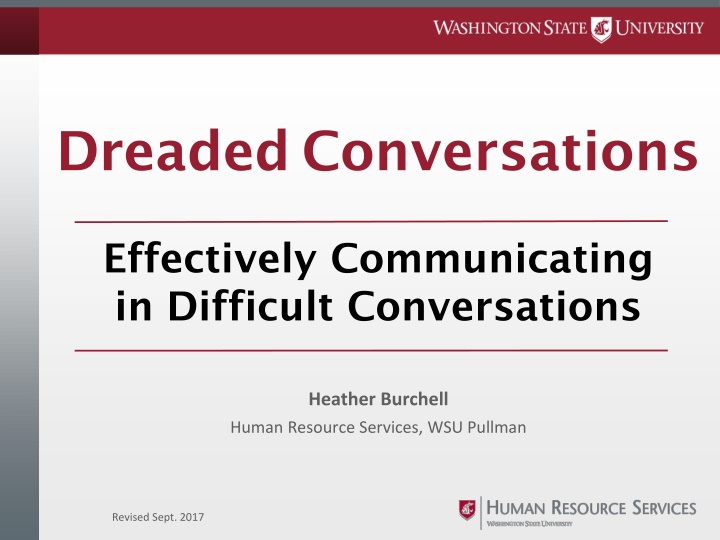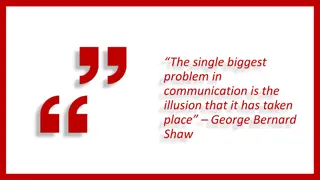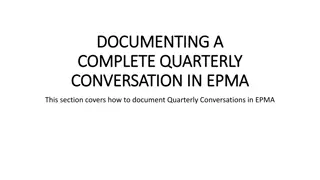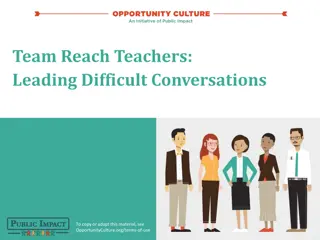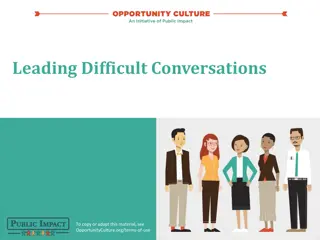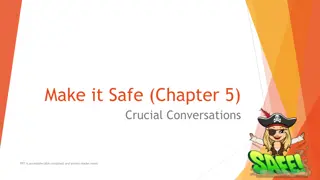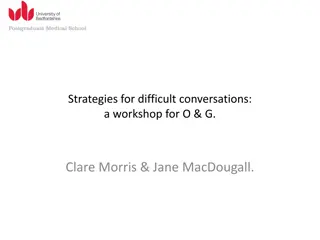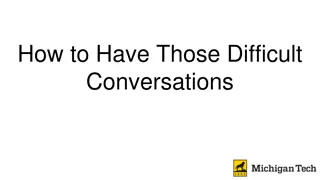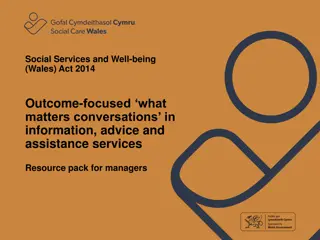Effective Communication in Difficult Conversations: Strategies and Tips
Understanding the challenges of difficult conversations and how to effectively communicate in such situations. Prepare yourself before the conversation, focus on dialogue and common goals, and consider Maslow's Hierarchy of Needs. Learn how to handle heated discussions and navigate when things go wrong without compromising clarity and respect.
Download Presentation

Please find below an Image/Link to download the presentation.
The content on the website is provided AS IS for your information and personal use only. It may not be sold, licensed, or shared on other websites without obtaining consent from the author.If you encounter any issues during the download, it is possible that the publisher has removed the file from their server.
You are allowed to download the files provided on this website for personal or commercial use, subject to the condition that they are used lawfully. All files are the property of their respective owners.
The content on the website is provided AS IS for your information and personal use only. It may not be sold, licensed, or shared on other websites without obtaining consent from the author.
E N D
Presentation Transcript
DreadedConversations Effectively Communicating in Difficult Conversations Heather Burchell Human Resource Services, WSU Pullman Revised Sept. 2017
Why are these conversations so difficult? We are often caught off guard Adrenaline kicks in Fight or Flight response Decreased blood flow to the brain We have no time to think of our best response We say something that is counter-productive
Part One: Before the Conversation It starts with you!
Prepare yourself: What do you want? For the conversation? For yourself? For the other person? What preconceived notions do you have? About the other person? About their behavior and/or your concerns?
When the discussion gets heated: Dialogue shuts down and argument takes its place Dialogue: an exchange of ideas and opinions Goals: Establish common ground Establish common goals
Remember the what do I want? Pay attention to both the content and how the participants are communicating and feeling. Take active steps to encourage and allow the other participant to engage in the conversation completely. People are often upset not because of what we say but why they think we are saying it (our perceived motivation).
When things start to go wrong: If they re upset We sometimes try to soften the message. Instead, don t sugar coat your message clarify your intentions. Make sure you re considering lower-level needs such as respect (the esteem level on Maslow s Hierarchy).
When things start to go wrong: If we are upset We commonly react in a defensive manner and blame others. Again, we are often upset not because of what is said but why we think they are saying it. What is the worst and most hurtful way I can interpret this?
Remember: What they say about assumptions they re usually wrong. Be open minded and re-think your assumptions. You can only control your own behavior and try to improve your own communication. Try a curious approach, it is hard to be curious and defensive at the same time.
Things we tell ourselves... Excuses for our own bad behavior: It s not my fault, I m the victim here. It s all their fault; they re terrible, horrible, and no good! I had no other option. The only way to get them to listen is to yell and scream
"People were always talking about how mean this guy was who lived on our block. But I decided to go see for myself. I went to his door, but he said he wasn't the mean guy, the mean guy lived in that house over there. 'No, you stupid idiot,' I said, 'that's my house.'" ~ Jack Handey
Communications 2 to 1 Ratio We have two ears and one mouth so that we can listen twice as much as we speak. Epictetus (Greek philosopher)
The Numbers of Meaning In communication about feelings and attitudes, we receive our meaning: 55% based on what we see 38% based on how it sounds (tone, volume, and speed) 7% based on the actual words that are spoken Albert Mehrabian, UCLA professor
Be an Active Communicator. Hear the Words. Notice the Non-verbal Communication. Re-frame and Re-peat: In your own words, make sure that the message you received is the message that the sender intended
Speak from the Heart Hear and understand me. Even if you disagree, don t make me wrong. Acknowledge the greatness within me. Remember to look for my loving intention. Tell me the truth with compassion. Hyler Bracey, Managing from the Heart
Elements of a Difficult Conversation Content Relationship Process
Content What do you need to say? Make a list. Less is more as long as it s enough. Keep asking yourself, What s most important?
Relationship Who are you at work? You, the very fine person You, the job title
Relationship How do you balance YOU and YOU when they are in conflict? What message do you want to deliver? What message does the institution need to deliver, through you? Where do they overlap? (C.K. Gunsalus, The College Administrator s Survival Guide)
Process Focus on: the behavior, not the person a description, not an evaluation sharing information, not giving advice usefulness to the recipient, not satisfaction for you the most important information, not everything you d like to share
A structure for difficult conversations 1) Observe without evaluation. 2) State your feeling, being careful not to substitute thinking for feeling. 3) Express your need concretely. 4) Use clear, positive action language to make request. When your project report was late, I felt embarrassed and angry, because other people were waiting for that information. I need you to meet deadlines when I assign them and tell me right away if there are problems.
Practice a Difficult Conversation Pick a partner and practice, using the examples we're handing out. I saw . . . (Observe without evaluation.) (State your feeling, being careful not to substitute thinking for feeling.) I feel . . . I need . . . (Express your need concretely.) I request . . . (Use clear, positive action language to make request.)
Dreaded Conversation Practice Scenarios #1 you when you announced a new office policy that employees had to notify supervisors when they were making use of sick leave. At yesterday s staff meeting, an employee rolled his eyes at #2 could be overheard using profane language while talking loudly on her phone. Earlier today, an employee slammed her office door and #3 been late two or three times a week for the past month. Each week, you have met with the employee to clarify expectations. An employee was late to work today. This employee has #4 university community with incorrect deadline dates. Yesterday, an employee sent out an email notice to the
The Most Difficult Conversations Consult with experts first: Human Resources, the Attorneys-General, your supervisor. Prepare an outline, so you don t miss anything important. Be calm, clear, and straightforward. Allow the other person to express his or her emotions without being controlled by them. Create a firm conclusion to the conversation with next steps.
Action/Results When you ve successfully handled a dreaded conversation, make sure it wasn t a wasted effort. Decide what the follow-through will be: Who does what, by when, and follow-up (how, when, who).
This has been a WSU Training Videoconference If you attended this live training session and wish to have your attendance documented in your training history, please notify Human Resource Services within 24 hours of today's date: hrstraining@wsu.edu
